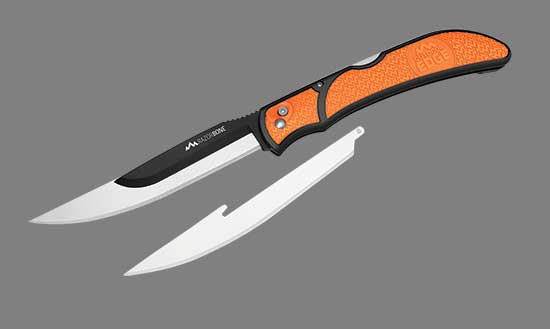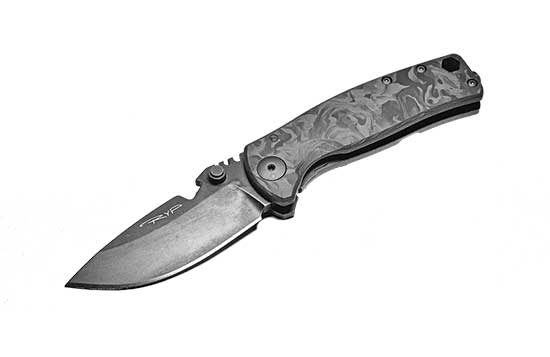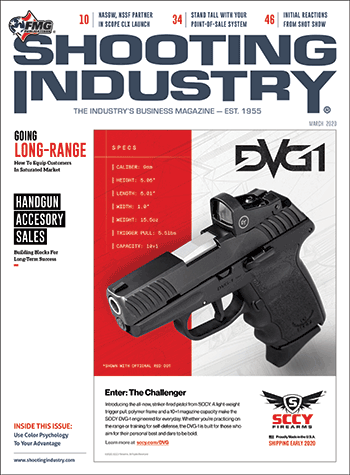Knife Profits
Old Reliable Vs. Hot New Tech?
It’s a dilemma every retailer faces, especially when SHOT Show rolls around and hot new products are tempting their buying taste buds at every turn. It’s enticing to buy a manufacturer’s latest knives but then a little voice says, “Wait! We sell a lot of their old standards as well.” It’s a quandary for many retailers who sell firearms, knives and accessories: Do you invest heavy in the new and less in the old, or vice versa?
We had a chance to ask Chris Brooks, the director of brand management for Buck Knives — a long-standing U.S. cutlery manufacturer that offers a healthy range of both popular traditional models and exciting new high-tech fare.
“The Buck 110 Folding hunter knife changed the cutlery industry and became an American icon for Buck Knives. It’s our flagship product and loved by so many — all its siblings were created from customer feedback and demand. Any and all versions of the 110 are an instant success for us,” Brooks shared.
The same concept applies to Buck’s classic WWII-era 119 series of fixed blades.
“The 119 is over 75 years old, while the 110 was introduced more than 50 years ago,” he added.
Not a company to sit on its laurels, the multiple lines of state-of-the-art cutlery in Buck Knives’ stable is freshened annually.
“It’s important to keep up with the changing needs of the consumer,” Brooks noted. “New technology, processes and materials allow us to constantly innovate and provide products we wouldn’t have been able to manufacture in the 1940s through the 1960s. The newer models are often designed for specific tasks — offering different steels, sure- grip handle materials, safety mechanisms and other features to make end use easier and more comfortable.”
Old Meets New
Brooks has a simple solution to the question of offering your customers proven sellers versus new technology: Sell both.
“It revolves around trust. Most people will recognize the classic knives their dad, uncle or grandpa had. They’ve seen them put to work countless times,” he said.
For companies like Buck that have cultivated a positive reputation, goodwill built up over generations speaks to the quality of a company’s offerings. Your older customer already has a good impression of a particular brand and may be tempted to upgrade to the additional features found in newer, high-tech knives from the company. Likewise, those customers who straddle the generation gap between old and new are already predisposed to one brand or another and can easily transition to the newer technology or stay with the old — or both — if they’re die-hard fans.
With a little bit of research, old and new products can work side by side
in your store to please your entire customer base — maximizing profits and
adding black ink to the bottom line.
Finally, by carrying both old and new knives the young customer can receive an education on the brand and develop trust through osmosis. Speaking of younger customers, Brooks revealed an unexpected observation.
“It’s surprising how many younger clientele go for the classics based on influence from someone they know who has used them. We also notice those customers who love to try out any new knife, regardless of age, as long as it’s American-made.” Simply put, there is a symbiotic relationship between the older, proven sellers and the flashy new models. The old sells the new and the new sells the old.
A Retailer’s Perspective
Jeff Chastain, the marketing and buying director for Simmons Sporting Goods (Bessemer, Ala.), shared his store devotes most of its knife inventory to traditional top sellers.
“Normally, we purchase approximately 80% of the traditional sellers versus 20% of the new offerings,” he informed. “Of course, taking time to view past sales and current inventory can give you a rough idea of how to forecast orders and achieve seasonal turns.”
Chastain also notes the importance of staying in touch with customers.
“You have to tailor buying demands to meet the demands of your customer base. A younger customer will demand the latest high-tech products, while the older segment tends to purchase the traditional tried-and-true items.”
As Chastain points out, knowing your customer is key. If your store is geared more to tactical firearms and accessories you might very well experience a drastically different percentage of sales for modern, high-tech merchandise as many of these customers are looking for the “latest and greatest” over the older offerings.
Additionally, as noted, age is a big factor. The younger tactical target shooters are going to have different demands than the older traditional trap and skeet crowd. Know your customer and wise buying decisions will come.
From the manufacturer level, Brooks adds one final bit of advice.
“Don’t overlook the many aids manufacturers offer retailers to assist them in making a sale. We have various display options and programs, including training through the ExpertVoice program. We also have various leave-behind materials for store associates,” he concluded.
With a little bit of research, old and new products can work side by side in your store to please your entire customer base — maximizing profits and adding black ink to the bottom line. Are you getting your fair slice of the pie?









